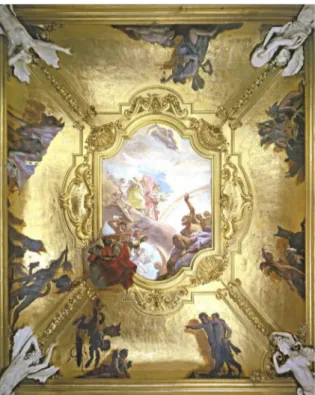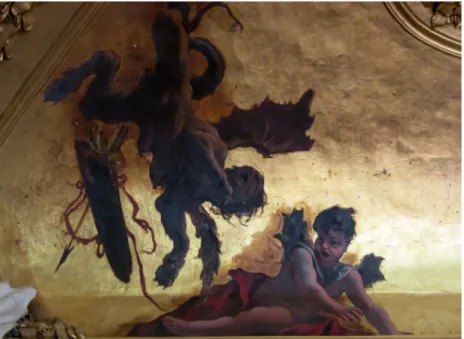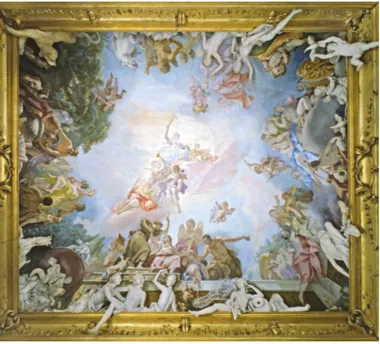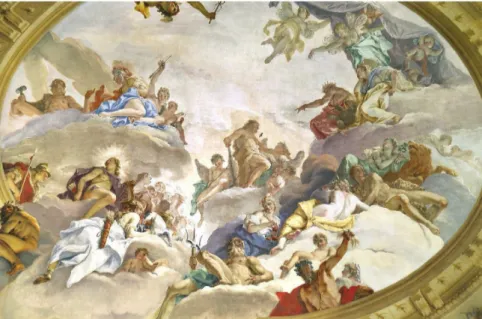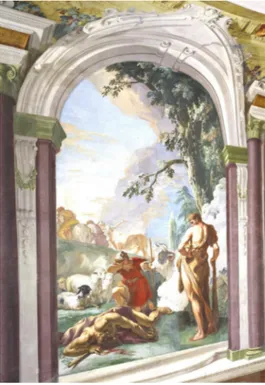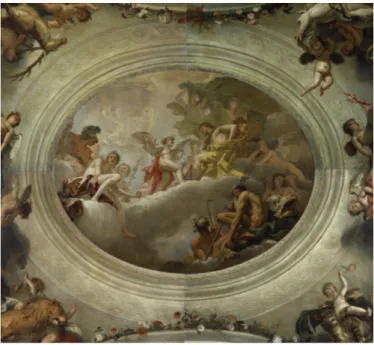JOURNAL OF THE SECTION OF CULTURAL HERITAGE
Department of Education, Cultural Heritage and Tourism University of Macerata
08
S
U
PP
LEMENT
I
IL CAPITALE CULTURALE
Studies on the Value of Cultural Heritage
Nuove letture e prospettive
di ricerca per il Settecento
europeo
IL CAPITALE CULTURALE
Studies on the Value of Cultural Heritage
Supplementi 08
/
2018
Il Capitale culturale
Studies on the Value of Cultural Heritage Supplementi 08, 2018 ISSN 2039-2362 (online) ISBN 978-88-6056-586-0 Direttore / Editor Massimo Montella Co-Direttori / Co-Editors
Tommy D. Andersson, Elio Borgonovi, Rosanna Cioffi, Stefano Della Torre, Michela di Macco, Daniele Manacorda, Serge Noiret, Tonino Pencarelli, Angelo R. Pupino, Girolamo Sciullo
Coordinatore editoriale / Editorial Coordinator Francesca Coltrinari
Coordinatore tecnico / Managing Coordinator Pierluigi Feliciati
Comitato editoriale / Editorial Office
Giuseppe Capriotti, Mara Cerquetti, Francesca Coltrinari, Patrizia Dragoni, Pierluigi Feliciati, Valeria Merola, Enrico Nicosia, Francesco Pirani, Mauro Saracco, Simone Sisani, Emanuela Stortoni
Comitato scientifico - Sezione di beni culturali / Scientific Committee - Division of Cultural Heritage and Tourism
G i u s e p p e C a p r i o t t i , M a r a C e r q u e t t i , Francesca Coltrinari, Patrizia Dragoni, Pierluigi Feliciati, Maria Teresa Gigliozzi, Susanne Adina Meyer, Massimo Montella, Umberto Moscatelli, Sabina Pavone, Francesco Pirani, Mauro Saracco, Emanuela Stortoni, Federico Valacchi, Carmen Vitale
Comitato scientifico / Scientific Committee Michela Addis, Tommy D. Andersson, Alberto Mario Banti, Carla Barbati, Sergio Barile, Nadia Barrella, Marisa Borraccini, Rossella Caffo, Ileana Chirassi Colombo, Rosanna Cioffi, Caterina Cirelli, Alan Clarke, Claudine Cohen, Lucia Corrain, Giuseppe Cruciani, Girolamo Cusimano, Fiorella Dallari, Stefano Della Torre, Maria del Mar Gonzalez Chacon, Maurizio De Vita, Michela di Macco, Fabio
Donato, Rolando Dondarini, Andrea Emiliani, Gaetano Maria Golinelli, Xavier Greffe, Alberto Grohmann, Susan Hazan, Joel Heuillon, Emanuele Invernizzi, Lutz Klinkhammer, Federico Marazzi, Fabio Mariano, Aldo M. Morace, Raffaella Morselli, Olena Motuzenko, Giuliano Pinto, Marco Pizzo, Edouard Pommier, Carlo Pongetti, Adriano Prosperi, A n g e l o R . P u p i n o , B e r n a r d i n o Quattrociocchi, Margherita Rasulo, Mauro Renna, Orietta Rossi Pinelli, Roberto Sani, Girolamo Sciullo, Mislav Simunic, Simonetta Stopponi, Michele Tamma, Frank Vermeulen, Stefano Vitali
Web
http://riviste.unimc.it/index.php/cap-cult e-mail
Editore / Publisher
eum edizioni università di macerata, Centro direzionale, via Carducci 63/a – 62100 Macerata tel (39) 733 258 6081 fax (39) 733 258 6086 http://eum.unimc.it [email protected] Layout editor Marzia Pelati
Progetto grafico / Graphics +crocevia / studio grafico
Rivista accreditata AIDEA Rivista riconosciuta CUNSTA Rivista riconosciuta SISMED Rivista indicizzata WOS
La Galleria dell’Eneide di Palazzo Buonaccorsi a Macerata.
Nuove letture e prospettive di ricerca per il Settecento europeo
* Gli interventi presentati in questo volume sono stati selezionati fra quelli pervenuti in risposta a una call for paper dal comitato scientifico del convegno “La Galleria di palazzo Buonaccorsi a Macerata: nuove letture e prospettive di ricerca per il Settecento europeo” (Macerata, Università di Macerata e Musei Civici di palazzo Buonaccorsi, 21-23 giugno 2017), promosso dall’Università di Macerata, Dipartimento di Scienze della Formazione dei Beni culturali e del Turismo, con il patrocinio di SISCA (Società Italiana per lo Studio della Critica d’arte).
Comitato scientifico
Gabriele Barucca (già Soprintendenza ABAP delle Marche-Ancona), Silvia Blasio (Università di Perugia), Enzo Borsellino (Università di Roma Tre), Giuseppe Capriotti (Università di Macerata) Vittorio Casale (Università di Roma Tre), Claudia Cieri Via (Università La Sapienza di Roma), Rosanna Cioffi (Università degli studi della Campania “Luigi Vanvitelli”), Francesca Coltrinari (Università di Macerata), Valter Curzi (Università La Sapienza di Roma), Patrizia Dragoni (Università di Macerata), Daniela Del Pesco (Università di Roma Tre), Michela di Macco (Università La Sapienza di Roma), Elena Fumagalli (Università di Modena e Reggio Emilia), Andrew J. Hopkins (Università degli Studi dell’Aquila), Riccardo Lattuada (Università degli studi della Campania “Luigi Vanvitelli”), Lauro Magnani (Università di Genova), Sergio Marinelli (Università di Venezia), Susanne Adina Meyer (Università di Macerata), Raffaella Morselli (Università di Teramo), Mario Alberto Pavone (Università di Salerno), Cecilia Prete (Università di Urbino), Massimiliano Rossi (Università del Salento, Presidente SISCA), Orietta Rossi Pinelli (Università La Sapienza di Roma), Gianni Carlo Sciolla † (già Presidente SISCA), Alessandra Sfrappini (Istituzione Macerata Cultura Biblioteca e Musei), Cinzia Maria Sicca (Università di Pisa).
La Galleria dell’Eneide di Palazzo
Buonaccorsi a Macerata.
Nuove letture e prospettive di
ricerca per il Settecento europeo
a cura di Giuseppe Capriotti, Francesca Coltrinari,
Parte III
Maffeis R., The Painter at the Crossroads: Sebastiano Ricci in Florence and the Interplay between the Arts «Il Capitale culturale», Supplementi 08 (2018), pp. 471-487
ISSN 2039-2362 (online); ISBN 978-88-6056-586-0 DOI: 10.13138/2039-2362/1844
The Painter at the Crossroads:
Sebastiano Ricci in Florence and
the Interplay between the Arts
Rodolfo Maffeis*
Abstract
This paper examines Sebastiano Ricci’s pictorial activity in Florence, with the aim of elucidating the sophisticated set of visual references through which the Venetian painter enriched his culture during his stay in the Tuscan city. The study addresses at first the decorative cycle of Palazzo Marucelli, a close analysis of which reveals Ricci’s fascination for the Florentine sculpture of the Cinquecento. New hints are then given on the painter’s articulated relationship with Florentine “stuccatori” and “quadraturisti”, who worked alongside him in the palace. Lastly, the article focuses on some relevant English commissions, where previous experiences converge, however with some minor changes aimed at meeting the aesthetic demands of the foreign audience.
Il presente contributo esamina l’attività pittorica di Sebastiano Ricci a Firenze, analizzando il sofisticato complesso di riferimenti visivi con i quali il pittore veneto
* Rodolfo Maffeis, Ricercatore di Storia dell’arte moderna, Politecnico di Milano, Dipartimento di Design, Via Durando 38/a, 20158 Milano, e-mail: [email protected].
This study is part of a larger research project on Ricci to which I could devote myself as Andrew W. Mellon Fellow in the Department of European Paintings at the Metropolitan Museum of Art in 2014-2015. My sincerest thanks to Keith Christiansen, Andrea Bayer, Xavier F. Salomon and Stephan Wolohojian for their tutorship, encouragement and fruitful conversation.
472 RODOLFO MAFFEIS
arricchisce la propria cultura durante la sua permanenza nella città toscana. Lo studio sonda dapprincipio l’influenza, sia iconografica che stilistica, della grande scultura fiorentina del Cinquecento nel ciclo decorativo di Palazzo Marucelli. Quindi tratteggia alcuni aspetti innovativi dell’articolato rapporto di Ricci con gli stuccatori e i quadraturisti fiorentini che lo affiancarono nell’impresa. Infine si sofferma sui cantieri inglesi nei quali tali esperienze precedenti confluiscono, ma dove intervengono anche sottili modifiche legate alle aspettative estetiche di un pubblico non italiano.
One of the most important stages of Sebastiano Ricci’s artistic pilgrimage was Florence. Early contacts between the Gran Principe Ferdinando de’ Medici and the painter date from 1704, through Niccolò Cassana in Venice, and concern the commission of an altarpiece for the church of San Francesco de’ Macci. The Medici’s updated patronage must have subsequently led the painter to the city between 1705 and 17071.
When he was in Florence, Sebastiano also weaved relationships with some of the members of the aristocracy, which longed to align themselves with the patronage of the reigning family. And possibly challenge it. These contacts did not always lead to good results: for the Gaddi family, for example, Ricci designed an Allegory of Tuscany whose preparatory drawing still exists, with
a note in a contemporary hand: «Not executed because it was not possible to reach an agreement on the price»2.
On another occasion, however, the Florentine aristocrats were less stingy and more forward-looking, and Ricci created for them a painted decoration that is unanimously considered as the birth certificate of the Italian Rococo. It
was the case of the Marucelli3.
Palazzo Marucelli on Via San Gallo, Florence, is located not far from the ancient Palazzo Medici di Via Larga, a landmark of the district of the city most closely connected with the early Medici. The Marucelli palace bears a façade designed by Gherardo Silvani around 1630, whose somewhat severe
1 For the documentation and discussion on Ricci’s contacts and permanence in Florence see:
Haskell 2000, p. 387, doc. A; Daniels 1973; D’Arcais 1973a, pp. 18-19; Daniels 1976, pp. XIII, 28-38; Del Torre 2002; I. Bigazzi, in Bigazzi, Ciuffoletti 2002, pp. 43-65, 130-164; F. Farneti, in Farneti, Bertocci 2002, pp. 72-74; Scarpa 2006, pp. 29-34, 64-65; Röttgen 2007, p. 334; M. Chiarini, in Pavanello 2010, pp. 62, 66; Freddolini 2013, pp. 57-59, 166-168, 170-171; Stefani 2015, pp. 80-84, 159-162.
2 «Bastian Ricci Veneziano Il modello è in Palazzo de’ Pitti che fu fatto p(er) farlo Fresco in
Casa Gaddi e non ne fu fatto altro o(er) non esser stati d(‘accordo) del Prezzo» (cf. D’Arcais 1973c, p. 6; Daniels 1976, pp. 29-30; Marinelli G., in Pavanello 2010, p. 68). Ricci’s fees were notoriously high. Angiola Pellegrini wrote in a letter to Rosalba Carriera (dated 9 june 1714) that some of the painter’s English patrons were afraid of his requests (cf. Daniels 1976a, p. XVII; Sani 1985, pp. 282-283; X. Salomon, in Pavanello 2010, p. 72).
3 A long line of authoritative scholars (Longhi, Pallucchini, Haskell, D’Arcais, Rosenberg)
indeed shares the opinion that the main features of eighteenth-century decoration were ultimately rooted in this cycle, cf. Daniels 1976a, p. XIII. See also Röttgen 2007, pp. 330-343.
473
THE PAINTER AT THE CROSSROADS
style derives from the great Roman palaces of the Renaissance4. At the height
of the Baroque Age the Palazzo Medici was decorated with frescoes by Luca Giordano. Relying on this precedent, in the first decade of eighteenth century, Sebastiano Ricci was commissioned to create a cycle of both frescoes and canvases in five rooms on the first floor of the Marucelli palace5.
The family had come to wealth in the previous century with the silk trade, but at the beginning of the eighteenth century their activities were based mainly on baking and politics. In those days the family had close ties with the Medici: of the male descendants, Giovanni Filippo was a member of the holy order and secretary of State to the Grand Duke, while his brothers – Orazio and Giuseppe – were both senators6. Not surprisingly, such political connections played a
role in the iconography of the cycle; moreover the painter himself shown an apt readiness to incorporate the distinct visual tradition of the city and of its sculptural tradition in particular, thus taking an active part in the process of adaptation of the decoration to the Florentine context7.
The first room is dedicated to the The Golden Age (fig. 1). In the central
compartment Peace and Abundance walk over the clouds while Mars – the god of war – is pushed out of the heavens. Around the central scene, some
putti and Furies in naturalistic colors stand out against a gold background.
The reflections of the large gold surface dazzle. This gold background was a true innovation in Florence and possibly brings memories of the mosaics of San Marco in Venice. The figure of Mars is painted on a raised area of stucco
to emphasize the impression of a realistic fall beyond the frame. Although the source of this three-dimensional effect can be identified in the baroque frescoes by Giovan Battista Gaulli in the Church of the Gesù in Rome, here the illusion is not aimed at persuasion in a religious sense, but just at pure entertainment: the intellectual pleasure of the iconography is enhanced by the optical – and almost tactile – illusion of Mars flowing over the frame. In a way, the falling
4 For a thorough reconstruction of the history of the palace and its owners, see I. Bigazzi, in
Bigazzi, Ciuffoletti 2002, chapters I-III.
5 The main bibliographical references on Ricci’s interventions at Palazzo Marucelli are: Haskell
2000, pp. 240-241, 387; Daniels 1973; D’Arcais 1973a-b-c; M. Chiarini, in Rossen 1974, pp. 158-159, 304-305; 308-309; Daniels 1976a, pp. XIII, 32-38; Daniels 1976b, pp. 106-108; I. Bigazzi, in Bigazzi, Ciuffoletti 2002, passim; Scarpa 2006, pp. 29-34, 187-193; Röttgen 2007, pp. 330-343; V. Conticelli, in Sisi, Spinelli 2009, pp. 156-159, 178-181; M. Chiarini, in Pavanello 2010, pp. 62-65; P. Maccioni, in Gregori, Visonà 2012, pp. 48-51; C. Brovadan, in Gregori, Visonà 2015, pp. 156-160.
6 I. Bigazzi, in Bigazzi, Ciuffoletti 2002, pp. 31-81.
7 Among the scholars who noticed somewhat the influence of Florentine sculpture in the cycle,
only Isabella Bigazzi carried out a first, substantial survey of possible sources (see I. Bigazzi, in Bigazzi, Ciuffoletti 2002, pp. 55-56, 146, 157, 160-163). Freddolini (2013, p. 58) is inclined to think that Ricci aimed at challenging the local sculptural masterpieces within the rhetorics of the paragone debate. Others addressed the topic briefly and exclusively in connection with the fictive marble group of Hercules and Antaeus in the Room of Hercules (see discussion below): Pilo 1976, p. 45; Daniels 1976a, pp. 36-38; Scarpa 2006, p. 33; Röttgen 2007, p. 335.
474 RODOLFO MAFFEIS
god is “becoming incarnate” through the mutual help of the painting and the
stucco relief.
Here we find a first declaration of what will be Ricci’s innovation in these rooms: overcoming the theoretical opposition of the long standing debate on the paragone between the arts, the painter mixes the two media to increase the
amazement, and then the enjoyment, of the viewer.
What gold does, basically, is to change color and multiply the reflections according to the source of illumination. The apartment was intended for summer use, hence it was principally approached from the garden. The room has two windows that provide good daylight, but in the evening, in the candlelight, the effect of movement of the putti on the shiny golden vaults had to be intense. The
surface indeed is not flat, but concave, and dense shadows play on it. A hitherto unpublished preparatory drawing for the scene of The Golden Age, – where
a putto harnesses a wolf and a lamb while two others burn trophies of war
(Windsor, RL 7128, fig. 2)8 –, shows that such an emphasis on shadows was
already there, in the first thought of the painter. Furthermore, in a nice contrast of materials, the fur of the wolf and the wool of the lamb – resting together as a sign of Peace (Isaiah 11.6) – make a statement of naturalism against such a precious background.
The ceiling contains a political message: in another section a Fury is hurling a torch at two putti, who protect themselves by hiding beneath a standard with
the coat of arms of the Marucelli. The scene is a reference to the role of peace keeper of Giovanni Filippo, who was appointed Knight of Santo Stefano and used to live in these rooms.
A subtle tribute to the Medici patronage is the representation of the Sleeping Cupid, on which a nymph is scattering flowers. One of the most famous pieces of the grand-ducal collections was indeed the Sleeping Cupid by Caravaggio,
a painted version of the ancient sculpture that, according to Vasari, was also imitated by the young Michelangelo. Caravaggio’s Cupid has a pale and cadaverous body, starkly illuminated in grazing light, and has the black wings of a raven. Ricci’s child is fair less dramatic, but undoubtedly related to that precedent. A tribute to the same Medici piece had already been commissioned by the family Dell’Antella in 1620, when they had it portrayed by Giovanni da San Giovanni on the façade of their palace in Piazza Santa Croce, where it still can be seen, although worn by four centuries of sun and rain.
A powerful complement to Ricci’s fresco, is that of the two Tritons and two Nereids modeled out of stucco in very high relief in the corners of the room.
The Tritons appear to be desperate for the fall of Mars, while the Nereids play musical instruments to express their joy at the advent of Peace. According to the documents, Giovanni Baratta was responsible for these stucchi, being
475
THE PAINTER AT THE CROSSROADS
paid for them in September 17059. However, due to the unparalleled intensity
of these works in Baratta’s career and their stylistic similarities with Ricci’s frescoes, there is a general critical agreement that the latter might have supplied the preparatory drawings10.
If one compares Baratta’s sculptural details to Ricci’s Taming of Cupid on
the ceiling of another room, close affinities not only in the posture but also in the substance of the flesh become evident. And there is definitely a connection between the free brushstrokes of the eyes, nose and lips of the Venus in the same painting and the handling in the putty-knife work of the Nereids.
Ricci again reprised the type of the Triton when he envisioned the fictive bronzes, painted in dark green with gilded highlights, in the four corners of the last and main room: the Salone d’Ercole. A further example of the tight stylistic
affinity between the stucchi and the frescoes is in the flying Fury that falls over
a scared putto (fig. 3). The monster can be easily compared with analogous creatures modeled out of stucco on the gold leaf in an adjacent room, which
holds no paintings by Ricci, but where his teaching clearly resonates (fig. 4). The main theme of the second room can be defined as Youth choosing between Virtue and Vice (fig. 5). It is a joyful composition which – far from
stigmatizing the decadence of vices – depicts instead a festive celebration of the pleasures of life. The intense coloring of the figures along the edges creates a
chiaroscuro contrast and a three-dimensional effect of nearly tangible bodies,
that gradually fades in the brightness of the sky on top of the vault.
But what amazes the beholder is the interaction between the stucco figures
in very high relief and the painted scenes: the stucchi not only help to unify
the whole composition by providing an intermediate zone between the walls and the ceiling, additionally they create a true counterpart to the frescoes. Painted lovers are flanked by stucco nymphs pouring flowers; tritons are riding marine horses in stucco sea waves; images of men laying on the cornice possibly
deriving from the Torso del Belvedere correspond to figures of gods with
high-arched backs in the frescoes11.
The game of mirrors between painting and sculpture is epitomized in a joke in a corner of the second room, where a colored stucco monkey – famously
associated with Painting in Renaissance art treatises – looks into the mouth of a lion, whose tail is frescoed while the rest of the body gradually emerges from the wall, with the head and paws of stucco in high relief (fig. 6).
This detail has been overlooked so far, whereas it’s very revealing. The iconographic reference is a tale of Phaedrus in which the lion, in an attempt to approach and devour the monkey, asks her if his breath stinks. Instead she
9 Freddolini 2013, p. 168.
10 D’Arcais 1973b, p. 19; Scarpa 2006, p. 31.
11 Bigazzi pinpoints several citations of the Hellenistic marble in the frescoes, cf. I. Bigazzi, in
476 RODOLFO MAFFEIS
responds that it smells of cinnamon as do the altars of the gods. Then the lion, pleased by the flattery, abandons his purpose and leaves the monkey alive. Astuteness of the animal, painter’s wit: perhaps foreshadowing the superior deceptive abilities of painting over the pompous regality of sculpture.
Ricci’s meditation on sculpture reaches its peak in the main hall. The Room of Hercules is entirely frescoed from the floor to the ceiling. On the walls, the
Labors of Hercules can be seen through three arched openings, flanked by porphyry columns with bronze capitals and marble arches12. The remaining
areas are inhabited by young smiling putti and satyrs, fruit garlands and white
fictive statues of Allegories against gold background. The Ascension of Hercules to the Olympus decorates the vault within an oval framework, which emulates
the opening of the heavens (fig. 7).
The Florentine specialist Giuseppe Tonelli (1668-1732) was responsible for the highly innovative quadratura13. Detached from the bold illusive Baroque
architectures, his painted arcades are light, open, and theatrical, allowing Ricci’s figures to move, expand, and fly in a boundless, luminous space which foreshadows Tiepolo’s frescoes. The lightness of his architectural arrangement, based on strong color contrasts – violet, green, white, gold – is what gives the painting freedom to unfold without being forced into a corset of vanishing lines.
The character of Hercules was connected to the imagery and iconography of Florence since its foundation. As a symbol of city pride and Medici power the hero is recalled in many statues and paintings such as Bandinelli’s group in front of the entrance of the Palazzo Vecchio, or Pietro da Cortona’s ceiling pictures in the Palazzo Pitti. There is no doubt that, by choosing such a theme, the Marucelli intended to openly honor the reigning family14. At a deeper
level the frescoes also hide a subtle network of references to the Medici’s artistic patronage: among many examples we may mention the Mercury by
Giambologna, while some echoes of Michelangelo’s tombs can be seen in the figure of Neptune laid over the clouds.
On the walls, The Fight of Hercules and the Centaur is openly composed
after the imposing marble group by Giambologna (fig. 8), whose political implications in relation to its original location at the Canto de’ Carnesecchi have been perceptively elucidated by Michael Cole15. Once again, Marucelli’s
desire to flatter the Medici led to the insertion of an iconographic reference that turned into a stylistic suggestion for Ricci.
For the scene of Hercules and Cacus, Sebastiano relies on two distinct models
of exceptionally muscular male bodies. In the bozzetto (fig. 9) he composes the
12 The basic features of the architectural arrangement derive from the Salone di Giovanni da
San Giovanni in Palazzo Pitti, see: D’Arcais 1973b, p. 22; Röttgen 2007, p. 334.
13 On Florentine Baroque quadratura see: Farneti, Bertocci 2002; Farneti, Lenzi 2004; Gregori,
Visonà 2012. On Tonelli: Raggi 2000; Farneti 2002; P. Maccioni, in Gregori, Visonà 2012, pp. 228-229; C. Brodavan, in Gregori, Visonà 2015, pp. 57-66; Brodavan 2016.
14 Cf. I. Bigazzi, in Bigazzi, Ciuffoletti 2002, p. 151 15 Cole 2011, pp. 263-273.
477
THE PAINTER AT THE CROSSROADS
figure after the Hercules Farnese, that could be seen in various engravings or
small bronze versions. Then he changes his mind and paints on the wall an entirely different Hercules (fig. 10): standing, viewed from behind with high-arched back, the head sunk between his shoulders, and a muscular texture that closely recalls the Neptune from the Ocean Fountain by Giambologna, at the
Boboli Garden16.
However, the key-image of this room is the monochrome, or rather the fictive statue, of Hercules and Antaeus (fig. 11). The composition is clearly indebted to
marble groups such as the Hercules and Antaeus by Vincenzo de Rossi (Firenze,
Palazzo Vecchio), The Rape of the Sabine Woman by Giambologna (under the
Loggia), and Ammannati’s bronze once atop the fountain designed by Niccolò Tribolo for Villa Medici at Castello17. Ricci’s version has a greater upward
thrust, from the extreme curvature of the bodies to the arm that crosses the frame, and the dramatic light effect from below. The preparatory drawing appears to be a vigorous dynamic knot where the form seeks to release itself from the tangle of lines (fig. 12): up to five arms are visible in a hectic process of corrections whose intermediate stages are deliberately left detectable. The drawing was presented by Ricci to Tonelli, who proudly wrote two lines at the bottom to commemorate the fact18. Tonelli also added the year – «1707» – a
date as pointed as the elbows agitated in the air.
To sum up: Ricci’s attraction for sculpture, almost absent in his previous work, grew intensely during his stay in Florence. References to the Medici iconography, stemming from Marucelli’s political connections, may have played a considerable role in the process. This had, in turn, a consequence on a stylistic level. Ricci’s painting achieved a greater accuracy and firmness, and an increase of plasticity. He began to sketch his figures one by one, or at most in pairs, with individual elegance and a taste for the contrapposto, thus leaving
behind the continuous figurative stream that was typical of the Baroque. It can be hardly denied that Ricci’s reuse of Mannerist formal prototypes conferred to his figures a swirling touch of elegance and a precision in drawing that they did not have before, and that such a cultural enrichment was part of shaping a distinctive eighteenth-century style.
Upon leaving Florence, Ricci returned to Venice where he came increasingly under the influence of Veronese and the great sixteenth-century painters,
16 For accurate information on this work and apposite photographs see the catalogue entry by
Dimitrios Zikos, in Paolozzi Strozzi, Zikos 2006, pp. 246-247. The entire volume is rich in analysis on various matters (from iconography to technical issues and the European diffusion of the artist’s inventions).
17 On these artists and the mentioned works see again the catalogue by Paolozzi Strozzi and
Zikos (2006), as well as Pizzorusso 2008; for a thorough discussion of Ammannati’s bronze see the catalogue entry by Mirella Branca in Paolozzi Strozzi, Zikos 2011, pp. 282-287; for a recent interpretative contribution on formal principles of Mannerist sculpture, its materiality and reception see Passignat 2011.
478 RODOLFO MAFFEIS
apparently forgetting about sculpture. However, some years later, in London, Florentine memories suddenly reappeared.
Around 1713-1714 he had established contact with the young Richard Boyle, 3rd Earl of Burlington, who commissioned the four canvases which decorated
the original staircase at Burlington House, Piccadilly. George Knox has labelled the cycle «A great Venetian decoration alla romana», maintaining that it was
marked by a strong resonance of Italian classicism19. Raphael’s Story of Cupid and Psyche in the Farnesina, Titian’s Bacchanals, and the Galleria Farnese have
been correctly identified as the main figurative sources. The celebrity of these works was enormous at that time, they were the must-sees of any “Italianate Englishman” on the Grand-Tour.
Nevertheless, in the ceiling above the main staircase, Ricci painted a canvas with Cupid before Jupiter (fig. 13) whose composition, enclosed within an
architectural fictive oval, turns out to be a selection of poses from that larger repertoire of the Sala d’Ercole which he had created some seven years earlier in
Florence.
The ensemble had a kind of an eclectic result. The overall impression is that, entering into this pantheon of aristocrats passionate about Classical art, Ricci had to follow the rules quite strictly. He succeeded in giving an Italian taste to the whole decoration, but he was allowed to re-use his Florentine repertoire just in a limited way. Despite all his efforts, Ricci could correspond only partially to the “Palladian” ambitions of Lord Burlington. The painter’s intimate connection with Mannerist sculpture ultimately distanced him from Classicism, bringing to a stylistic contradiction. Soon after, however, a different British patron employed Ricci for another mythological cycle, and on that occasion the artist was able to create a more coherent decoration.
A friend of Lord Burlington, Henry Bentinck, 1st Duke of Portland, was a
patron of Italian music and a lover of Italian art. As such he made the Grand Tour in 1701, accompanied by the historian Thoyras Rapin. Between 1712 and 1714, he commissioned two truly remarkable decorative cycles by Sebastiano Ricci: the first of which was for his house in London, St. James Square.
Of that program only one picture exists, which portrays the ceiling just partially (fig. 14). It was published in the Christmas issue of «Country Life» in 1937 just before the demolition of the building, which took place a year later20.
The subject is once again the Labors of Hercules in the large side niches, and a
triumph of the hero in the central compartment. The image is not easy to read, but with a bit of an effort one can discern several brazen self-citations from the Florentine Salone d’Ercole (i.e. the lunette with Hercules at the Crossroads).
Not everything comes from Florence, there are new labors and new compositional and formal choices, but yet the references to sculptural models
19 Knox 1985.
479
THE PAINTER AT THE CROSSROADS
are from the same figurative tradition. The detail of the Fight of Centaurs shows
tense lines of hyper-muscular arms as in Bandinelli’s groups, and Hercules and the Nemean Lion is all identical to the prototype by Giambologna, as can be
seen in the bronze casted in multiple versions.
As in the case of Burlington, Ricci was employed as an Italian painter to give an Italian taste to the residence. But apparently – unlike Burlington who had wanted to rediscover in his cycle the beloved samples by Raphael, Titian and Carracci – Bentinck’s approach as a patron had to be more liberal and his control over the painter’s choices less strict. So, instead of plagiarisms of the Bacchanals and the Farnesina, Ricci could go back, with variations, to his program for the Marucelli to produce a Venetian decoration alla fiorentina.
We must therefore conclude that his work for Portland, as well as the ceiling compartment at Burlington House, rooted as they are in the painter’s Tuscan experience, should be regarded as part of – let’s say – Ricci’s Florentine agenda in England. What had been created within a specific, rather political, communication strategy inherent to the connections between the Marucelli and the Medici, was confidently adapted to English private spaces, where the artist saw fit to use his most cultivated vocabulary, peppered with sculptural citations, to match the expectations of foreign patrons longing for Italian art. In the end, the smart monkey had once again deceived the majestic lion.
References / Riferimenti bibliografici
Bigazzi I., Ciuffoletti Z. (2002), Palazzo Marucelli Fenzi. Guida storico-artistica,
Firenze: Polistampa.
Brodavan C. (2016), Quadratura e scenografia nella grafica di Giuseppe Tonelli (Firenze, 1668-1732), in Alcune carte di varie maniere, di colori o d’altra fatta, Firenze: Edifir, pp. 49-60.
Cole M.W. (2011), Ambitious Form. Giambologna, Ammannati, and Danti in Florence, Princeton and Oxford: Princeton University Press.
Daniels J. (1973), Sebastiano Ricci and the Marucelli, «The Connoisseur», 183,
pp. 166-179.
Daniels J. (1976a), Sebastiano Ricci, Wayland: Hove.
Daniels J. (1976b), L’opera completa di Sebastiano Ricci, Milano: Rizzoli.
D’Arcais F. (1973a), I complessi decorativi fiorentini di Sebastiano Ricci - I,
«Antichità Viva», 12, 2, pp. 18-25.
D’Arcais F. (1973b), I complessi decorativi fiorentini di Sebastiano Ricci - II,
«Antichità Viva», 12, 4, pp. 15-28.
D’Arcais F. (1973c), I complessi decorativi fiorentini di Sebastiano Ricci - III,
«Antichità Viva», 12, 6, pp. 6-13.
480 RODOLFO MAFFEIS
corrispondenti, in Lettere artistiche del Settecento veneziano, I, a cura di A.
Bettagno, M. Magrini, Vicenza: Neri Pozza, pp. 3-27.
Farneti F., Bertocci S., a cura di (2002), L’architettura dell’inganno a Firenze.
Spazi illusionistici nella decorazione pittorica delle chiese fra Sei e Settecento,
Firenze: Alinea.
Farneti F. (2002), Giuseppe Tonelli, in Farneti, Bertocci 2002, pp. 65-81.
Farneti F., Lenzi D., a cura di (2004), L’architettura dell’inganno. Quadraturismo
e grande decorazione nella pittura di età barocca, Firenze: Alinea.
Freddolini F. (2013), Giovanni Baratta 1670-1747. Scultura e industria del
marmo tra la Toscana e le corti d’Europa, Roma: L’Erma di Bretschneider.
Rossen S., a cura di (1974), Gli ultimi Medici. Il tardo barocco a Firenze,
1670-1743, catalogo della mostra (Detroit, The Detroit institute of arts, 27 marzo – 2 giugno 1974; Firenze, Palazzo Pitti, 28 giugno – 30 settembre 1974),
Firenze: Centro Di; ed. eng. The Twilight of the Medici. Late Baroque Art in
Florence, 1670-1734, Firenze: Centro Di.
Gregori M., Visonà M., a cura di (2012), Fasto Privato. La decorazione murale
in palazzi e ville di famiglie fiorentine, I, Quadrature e decorazione murale da Jacopo Chiavistelli a Niccolò Contestabili, Firenze: Edifir.
Gregori M., Visonà M., a cura di (2015), Fasto Privato. La decorazione murale in
palazzi e ville di famiglie fiorentine, II, Dal Tardo Barocco al Romanticismo,
Firenze: Edifir.
Haskell F. (2000), Patrons and Painters: A Study in the Relations between
Italian Art and Society in the Age of the Baroque, New York: 1963; trad.
it. Mecenati e pittori. L’arte e la società italiane nell’età barocca, Torino:
Allemandi, 2000.
Knox G. (1985), Sebastiano Ricci at Burlington House: A Venetian Decoration
‘Alla Romana’, «The Burlington Magazine», Vol. 127, No. 990, pp.
600-609.
Paolozzi Strozzi B., Zikos D., a cura di (2006), Giambologna. Gli dei, gli eroi,
catalogo della mostra (Firenze 2006), Firenze: Giunti.
Paolozzi Strozzi B., Zikos D., a cura di (2011), L’acqua, la pietra, il fuoco.
Bartolomeo Ammannati scultore, catalogo della mostra (Firenze 2011),
Firenze: Giunti.
Passignat E. (2011), Twisting Marble: Observations on the Figura Serpentinata
and its Applications, in Revival and Invention. Sculpture through its Material Histories, edited by S. Clerbois, M. Droth, Bern: Lang, pp. 121-152.
Pavanello G., a cura di (2010), Sebastiano Ricci: il trionfo dell’invenzione
nel Settecento veneziano, catalogo della mostra (Venezia, 2010), Venezia:
Marsilio.
Pilo G.M. (1976), Sebastiano Ricci e la pittura veneziana del Settecento,
Pordenone: GEAP.
Pizzorusso C. (2008), Giambologna e la scultura della Maniera, Milano: Il
481
THE PAINTER AT THE CROSSROADS
Raggi G. (2000), Disegni di Giuseppe Tonelli, quadraturista a Firenze,
«Annuario della Scuola di Specializzazione in Storia dell’Arte dell’Università di Bologna», 1, pp. 81-104.
Röttgen S. (2007), Wandmalerei in Italien. Barock und Aufklärung: 1600-1800,
München: Hirmer 2007; trad. it. La grande decorazione barocca in Italia
1600-1800, Trento: Jaca Book, 2007.
Sani B. (1985), Rosalba Carriera: lettere, diari, frammenti, Firenze: L. S. Olschki.
Scarpa A. (2006), Sebastiano Ricci, Milano: Alfieri.
Sisi C., Spinelli R., a cura di (2009), Il fasto e la ragione. Arte del Settecento a
Firenze, catalogo della mostra (Galleria degli Uffizi, 30 maggio – 30 settembre 2009), Firenze: Giunti.
Stefani G. (2015), Sebastiano Ricci impresario d’opera a Venezia nel primo
482 RODOLFO MAFFEIS
Appendix
Fig. 1. Sebastiano Ricci and Giovanni Baratta, The Golden Age, Firenze, Palazzo Marucelli
Fig. 2. Sebastiano Ricci, A putto harnesses a wolf and a lamb while two others burn trophies of war, Windsor, RL 7128
483
THE PAINTER AT THE CROSSROADS
Fig. 3. Sebastiano Ricci, A Fury falling on a scared putto, Firenze, Palazzo Marucelli
484 RODOLFO MAFFEIS
Fig. 5. Sebastiano Ricci and Giovanni Baratta, Youth choosing between Virtue and Vice, Firenze, Palazzo Marucelli
485
THE PAINTER AT THE CROSSROADS
Fig. 7. Sebastiano Ricci and Giuseppe Tonelli, The Ascension of Hercules to the Olympus, Firenze, Palazzo Marucelli
Fig. 8. Sebastiano Ricci and Giuseppe Tonelli, The Fight of Hercules and the Centaur, Firenze, Palazzo Marucelli
486 RODOLFO MAFFEIS
Fig. 9. Sebastiano Ricci, Hercules and Cacus, Firenze, Le Gallerie degli Uffizi
Fig. 10. Sebastiano Ricci and Giuseppe Tonelli, Hercules and Cacus, Firenze, Palazzo Marucelli
Fig. 11. Sebastiano Ricci and Giuseppe Tonelli, Hercules and Antaeus, Firenze, Palazzo Marucelli
Fig. 12. Sebastiano Ricci, Hercules and Antaeus, Firenze, Gabinetto Disegni e Stampe degli Uffizi
487
THE PAINTER AT THE CROSSROADS
Fig. 13. Sebastiano Ricci, Cupid before Jupiter, London, Burlington House, Royal Academy of Arts
Fig. 14. Sebastiano Ricci, Labors and Apotheosis of Hercules, formerly London, Norfolk House (destroyed)
eum edizioni università di macerata
Direttore / Editor
Massimo Montella
Texts by
Gianpaolo Angelini, Giuseppe Capriotti, Rosanna Cioffi, Francesca
Coltrinari, Valter Curzi, Paolo Delorenzi, Valentina Fiore, Giulia Iseppi,
Roberto Carmine Leardi, Rodolfo Maffeis, Sergio Marinelli, Susanne
Adina Meyer, Angelo Maria Monaco, Désirée Monsees, Paolo Pastres,
Alberto Pavan, Arianna Petraccia, Chiara Piva, Cecilia Prete,
Massimiliano Rossi, Sara Rulli, Laura Stagno, Christina Strunck,
Andrea Torre
http://riviste.unimc.it/index.php/cap-cult/index
ISSN 2039-2362
JOURNAL
OF THE SECTION OF CULTURAL HERITAGE
Department of Education, Cultural Heritage and Tourism
University of Macerata
ISBN 978-88-6056-586-0 Euro 25,00
